Colón – Yesterday morning as we passed out of the city of Montevideo and headed north we passed through the port area of the city. An interesting sight met my eyes, as I noted bundles of 15 foot logs, stripped of their bark, roughly 20 to a bundle, piled along the docks. Not just a few bundles, but literally what must have been several thousand of them. Laura told me that they are eucalyptus logs, destined for Europe, where they are turned into paper pulp, to make, well, paper. Apparently this is one of Uruguay’s larger exports. Beyond just striking me as interesting, it’s of note in this moment in time because Uruguay and Argentina are embroiled in a battle over paper pulp. In a nutshell, there is a small town in Uruguay, Fray Bentos, along the river between the countries, in which a paper company is building a new paper plant – good for the local economy which has been a disaster since the economic collapse in 2001 if not longer, and, all those logs wouldn’t have to be shipped to Europe, they could be processed right here in Uruguay. The Uruguayans, in general, support it wholeheartedly. On the Argentine side of the river, across one of the few connecting bridges, in the city of Gualeguaychú, Argentines are protesting the potential pollution of the river, and thus, their lives. The paper company claims to have addressed all the ecological issues of concern and that they won’t be polluting the river, they’ve presented evidence to back their claim up. The Argentines don’t believe them, and given the history of many companies’ addressing of ecological concerns, they may be justified. For the last several weeks the Argentines have been blocking the bridge between the two towns which has caused major problems for tourists and commercial traffic. Just a momentary tangent there…
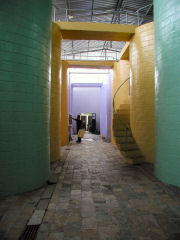 Our morning appointment found us headed to the town of Colón, a bit northwest of Montevideo, and home to the country’s largest wine exporter. Bodegas Carrau is the Uruguayan descendant of a mid-18th century vineyard outside of Barcelona. The Carraus came to Uruguay in the 1840s, but it wasn’t until they were joined by the Pujol family in the 1930s that they launched their Uruguayan venture. At one time, the winery’s focus was on producing Dubonnet for the French company that was its creator, but in the 1970s they set about converting the entire operation over to the production of fine wine. Today, Carrau produces one million bottles of wine per year, 35% for export (and representing roughly one-quarter of Uruguay’s entire wine exportation),
Our morning appointment found us headed to the town of Colón, a bit northwest of Montevideo, and home to the country’s largest wine exporter. Bodegas Carrau is the Uruguayan descendant of a mid-18th century vineyard outside of Barcelona. The Carraus came to Uruguay in the 1840s, but it wasn’t until they were joined by the Pujol family in the 1930s that they launched their Uruguayan venture. At one time, the winery’s focus was on producing Dubonnet for the French company that was its creator, but in the 1970s they set about converting the entire operation over to the production of fine wine. Today, Carrau produces one million bottles of wine per year, 35% for export (and representing roughly one-quarter of Uruguay’s entire wine exportation), 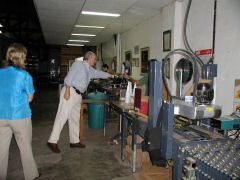 from two vineyards, one located in nearby Las Violetas, the other on the northeastern border with Brasil, in Rivera. Roughly 1,000 acres are planted to vines, the vast majority of it in the north. The winery is very modern, spotlessly clean, in fact there seemed to be people assigned to just wandering around cleaning anything they could. It’s also a colorful winery, with the large cinderblock, epoxy lined tanks painted in bright colors of aqua, yellow, and lavender. Javier Carrau, the current owner, greeted us and led us on a tour of the facilities, including a demonstration of the bottling and labelling line.
from two vineyards, one located in nearby Las Violetas, the other on the northeastern border with Brasil, in Rivera. Roughly 1,000 acres are planted to vines, the vast majority of it in the north. The winery is very modern, spotlessly clean, in fact there seemed to be people assigned to just wandering around cleaning anything they could. It’s also a colorful winery, with the large cinderblock, epoxy lined tanks painted in bright colors of aqua, yellow, and lavender. Javier Carrau, the current owner, greeted us and led us on a tour of the facilities, including a demonstration of the bottling and labelling line.
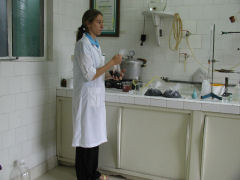 Here, Carrau’s enologist is squishing up baggies filled with grapes. She’s working with four different samples from various parts of the vineyards and testing the juice for the basic elements of structure that they are looking for before harvesting. The second, and somewhat odd picture, is a bit difficult to decipher if you don’t know what it is. Part of the process of making sparkling wine is to gradually shake the sediment down into the neck of the bottle, a process called riddling.
Here, Carrau’s enologist is squishing up baggies filled with grapes. She’s working with four different samples from various parts of the vineyards and testing the juice for the basic elements of structure that they are looking for before harvesting. The second, and somewhat odd picture, is a bit difficult to decipher if you don’t know what it is. Part of the process of making sparkling wine is to gradually shake the sediment down into the neck of the bottle, a process called riddling. 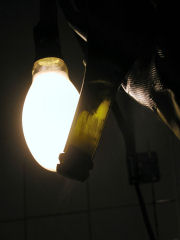 When the sediment is all collected, and fermentation is finished, the necks of the bottles are plunged into an ice water solution (-4°F) until the liquid in the neck freezes solid. Here, one of the team is holding up a bottle to a bulb to check that the “plug” is solid in the neck. He then sticks the neck of the bottle inside of a large plastic tub with a hole cut in the side, and reaches in and pops the cap off. The pressure in the bottle blows the ice plug out, shattering harmlessly inside the tub. The bottle is then topped up with wine from another bottle that’s already been opened and is used for topping up subsequent bottles, and then corked and sealed. Though I know the process from my studies, this was the first time I’d actually spent time watching it done.
When the sediment is all collected, and fermentation is finished, the necks of the bottles are plunged into an ice water solution (-4°F) until the liquid in the neck freezes solid. Here, one of the team is holding up a bottle to a bulb to check that the “plug” is solid in the neck. He then sticks the neck of the bottle inside of a large plastic tub with a hole cut in the side, and reaches in and pops the cap off. The pressure in the bottle blows the ice plug out, shattering harmlessly inside the tub. The bottle is then topped up with wine from another bottle that’s already been opened and is used for topping up subsequent bottles, and then corked and sealed. Though I know the process from my studies, this was the first time I’d actually spent time watching it done.
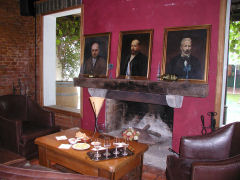
Bodegas Carrau’s beautiful tasting room, with various ancestors supervising.
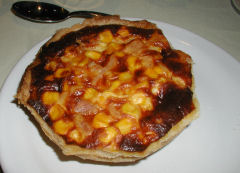 A simple, but somewhat heavier lunch than the day before was served about halfway through the tasting. We started off with a corn quiche, seasoned with bits of onion and prosciutto, which was good, if a touch underseasoned. We continued on to a delicious, but simple veal roast with a peppercorn rub rolled inside, and accompanied by a wonderful potato gratin. Despite the nearly inch-thick slab of meat that I managed to polish off the charming cook
A simple, but somewhat heavier lunch than the day before was served about halfway through the tasting. We started off with a corn quiche, seasoned with bits of onion and prosciutto, which was good, if a touch underseasoned. We continued on to a delicious, but simple veal roast with a peppercorn rub rolled inside, and accompanied by a wonderful potato gratin. Despite the nearly inch-thick slab of meat that I managed to polish off the charming cook 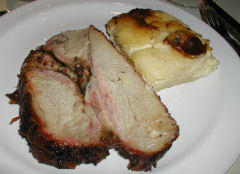 seemed highly disappointed when I didn’t go for a second one (they had to be an easy 8-10 oucnes each). I did manage another rectangle of gratin, though when I was looking away she slipped a third one on my plate, that I didn’t quite polish off. A little ice cream was served, though lunch finished slightly abruptly when several other winery owners showed up for a scheduled meeting and we were thanked and ushered to the door, forks still more or less in hand.
seemed highly disappointed when I didn’t go for a second one (they had to be an easy 8-10 oucnes each). I did manage another rectangle of gratin, though when I was looking away she slipped a third one on my plate, that I didn’t quite polish off. A little ice cream was served, though lunch finished slightly abruptly when several other winery owners showed up for a scheduled meeting and we were thanked and ushered to the door, forks still more or less in hand.
Mmm, mmm! At least the meals are improving. And some of those reds sound terrific.
Ahh, you should have tried the potatoes and the batatas from the day before’s lunch, that I gave instructions for. Those, were amazing! This was merely quite good. In fact, come to think of it, you should be here! This was your idea in the first place…
Oh yes, those “mashed potatoes” you raved about. Well, I’ll get there sometime, and then we can both revisit the best places.
[…] spent a fair amount of time talking about the now 250 year history of Bodega Carrau in my 2006 writeup, so I won’t go back through it. Brother and sister Javier and Margarita guided us through a […]